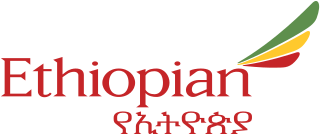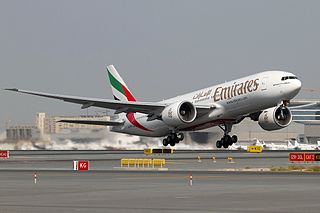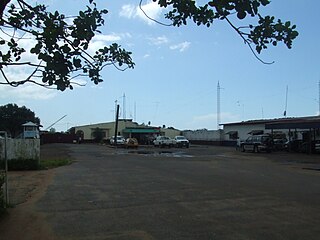
The Organisation of African Unity was an intergovernmental organization established on 25 May 1963 in Addis Ababa, Ethiopia, with 32 signatory governments. One of the main heads for OAU's establishment was Kwame Nkrumah of Ghana. It was disbanded on 9 July 2002 by its last chairman, South African President Thabo Mbeki, and replaced by the African Union (AU). Some of the key aims of the OAU were to encourage political and economic integration among member states, and to eradicate colonialism and neo-colonialism from the African continent.

The International Air Transport Association is a trade association of the world's airlines founded in 1945. IATA has been described as a cartel since, in addition to setting technical standards for airlines, IATA also organized tariff conferences that served as a forum for price fixing.

Ethiopian Airlines, formerly Ethiopian Air Lines (EAL), is the flag carrier of Ethiopia, and is wholly owned by the country's government. EAL was founded on 21 December 1945 and commenced operations on 8 April 1946, expanding to international flights in 1951. The firm became a share company in 1965 and changed its name from Ethiopian Air Lines to Ethiopian Airlines.

A flag carrier is a transport company, such as an airline or shipping company, that, being locally registered in a given sovereign state, enjoys preferential rights or privileges accorded by the government for international operations.
The freedoms of the air, also called five freedoms of air transport, are a set of commercial aviation rights granting a country's airlines the privilege to enter and land in another country's airspace. They were formulated as a result of disagreements over the extent of aviation liberalisation in the Convention on International Civil Aviation of 1944, known as the Chicago Convention. The United States had called for a standardized set of separate air rights to be negotiated between states, but most other countries were concerned that the size of the U.S. airlines would dominate air travel if there were not strict rules. The freedoms of the air are the fundamental building blocks of the international commercial aviation route network. The use of the terms "freedom" and "right" confers entitlement to operate international air services only within the scope of the multilateral and bilateral treaties that allow them.

Addis Ababa Bole International Airport is an international airport in Addis Ababa, Ethiopia. It is in the Bole district, 6 km (3.7 mi) southeast of the city centre and 65 km (40 mi) north of Bishoftu. The airport was formerly known as Haile Selassie I International Airport. It is the main hub of Ethiopian Airlines, the national airline that serves destinations in Ethiopia and throughout the African continent, as well as connections to Asia, Europe, North America and South America. The airport is also the base of the Ethiopian Aviation Academy. As of June 2018, nearly 380 flights per day were using the airport.

Hosea Kutako International Airport is the main international airport of Namibia, serving the capital city Windhoek. Located well east of the city, 45 km (28 mi), it is Namibia's largest airport with international connections. From its founding in 1965 to the independence of Namibia in 1990, it was named J.G. Strijdom Airport. In 1990 the airport was renamed, in honor of Namibian national hero Hosea Kutako.

Prince Said Ibrahim International Airport is an international airport serving Moroni in Comoros. It is named after Prince Saïd Ibrahim. It is located north of the village of Hahaya.

The African Union (AU) is a continental union consisting of 55 member states located on the continent of Africa. The AU was announced in the Sirte Declaration in Sirte, Libya, on 9 September 1999, calling for the establishment of the African Union. The bloc was founded on 26 May 2001 in Addis Ababa, Ethiopia, and launched on 9 July 2002 in Durban, South Africa. The intention of the AU was to replace the Organization of African Unity (OAU), established on 25 May 1963 in Addis Ababa by 32 signatory governments; the OAU was disbanded on 9 July 2002. The most important decisions of the AU are made by the Assembly of the African Union, a semi-annual meeting of the heads of state and government of its member states.

James Spriggs Payne Airport is an airport located 5 kilometres (3 mi) from downtown Monrovia, the capital of the Republic of Liberia in West Africa. The airfield is located within the busy and thickly settled Sinkor section of the city, and is therefore convenient to the business and political districts of the capital. Whereas Roberts International Airport is the primary aviation facility for the city and indeed the entire country, Spriggs-Payne has the only other paved runway in Liberia and once had the only other international commercial flights into and out of Liberia. The airport is named after James Spriggs Payne who was president of the Republic of Liberia in 1868–70 and again in 1876–78.
The African Union is a geo-political entity covering the entirety of the African continent. Its origin dates back to the First Congress of Independent African States, held in Accra, Ghana, from 15 to 22 April 1958. The conference aimed at forming the Africa Day to mark the liberation movement, each year, regarding the willingness of the African people to free themselves from foreign dictatorship, as well as subsequent attempts to unite Africa, including the Organisation of African Unity (OAU), which was established on 25 May 1963, and the African Economic Community in 1981. Critics argued that the OAU in particular did little to protect the rights and liberties of African citizens from their own political leaders, often dubbing it the "Dictators' Club".

The African Airlines Association, abbreviated AFRAA, is a trade association of African airlines. AFRAA was founded in Accra, Ghana, in 1968, and is, as of February 2021, headquartered in Nairobi, Kenya. The primary purpose of AFRAA is to establish and facilitate co-operation between African airlines.

ASKY Airlines is a private multinational passenger airline serving West and Central Africa, with its head office in Lomé, Togo, and its hub at Gnassingbé Eyadéma International Airport.
RwandAir Limited is the flag carrier airline of Rwanda. It operates domestic and international services to East Africa, Central Africa, West Africa, Southern Africa, Europe, the Middle East and Asia, from its main base at Kigali International Airport in Kigali.
The Cameroon Airlines Corporation, trading as Camair-Co, is an airline from Cameroon, serving as flag carrier of the country, a role which was previously filled by the now-defunct Cameroon Airlines. Camair-Co has its headquarters in the Immeuble La Rotonde in Douala, and operates out of Douala International Airport. The airline has never made a profit, and is struggling under the weight of its debts; most of its aircraft are currently grounded. The company slogan is French: L'étoile du Cameroun, The Star of Cameroon.

The African Continental Free Trade Area (AfCFTA) is a free trade area encompassing most of Africa. It was established in 2018 by the African Continental Free Trade Agreement, which has 43 parties and another 11 signatories, making it the largest free-trade area by number of member states, after the World Trade Organization, and the largest in population and geographic size, spanning 1.3 billion people across the world's second largest continent.

The Yamoussoukro Decision is a treaty adopted by most members of the African Union (AU) which establishes a framework for the liberalization of air transport services between African countries, as well as fair competition between airlines. The decision was signed by 44 African states in 1999, and became binding in 2002.

The 2018 Eritrea–Ethiopia summit was a bilateral summit that took place on 8–9 July 2018 in Asmara, Eritrea, between Eritrean President Isaias Afwerki and Ethiopian Prime Minister Abiy Ahmed and officials from the two countries.

The African Civil Aviation Commission is an agency of the African Union headquartered in Dakar. Its purpose is to develop and regulate civil aviation in Africa.















